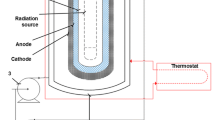Abstract
In a microcosm system where Elodea nuttallii and Bisphenol A (BPA) coexist, with the help of Liquid chromatography-mass spectrometer (LC-MS) and gas chromatography-mass spectrometer (GC-MS), the dynamics of phytodegradation of BPA with concentration 1–20 mg/L and the products of phytodegradation was studied. Antioxidation activity and phospholipids fatty acids were measured to evaluate the effects of BPA on E.nuttallii. The results showed that the half life period of phytodegradation of BPA was less than 15 days. 2-(4-hydroxypheny)-2-(3,4-o-dihydroxypheny) propane and 2, 2-bis(4-hydroxypheny) propyl alcohol were identified to be as two possible products of BPA. The peroxidase (POD) activity of E.nuttallii decreased by 50% to 100% compared with that controlled at the end of the experiment. The fatty acid methanol esters (FAMEs) changed obviously too. It showed that oxidation stress and membrane damage would be the two effecting aspects of BPA on E.nuttallii.
Similar content being viewed by others
References
Alexander H C, Dill L W, Smith P D, et al. Bisphenol A: Acute Aquatic Toxicity[J]. Environ Toxicol Chem, 1988, 7:19–26.
Charles A S, Philip B D, Gary M K, et al. A Review of the Environmental Fate, Effects, and Exposures of Bisphenol A[J]. Chemosphere, 1998, 10:2149–2173.
Zhou D N, Wu F, Deng N S, et al. Photooxidation of Bisphenol A (BPA) in Water in the Presence of Ferric and Carboxylate Salts[J]. Water Res, 2004, 38:4107–4116.
Goodson A, Summerfield W, Cooper I. Survey of Bisphenol A and Bisphenol F in Canned Foods[J]. Food Addit Contamn, 2002, 19:796–802.
Kang J H, Kito K, Kondo F. Factors Influencing the Migration of Bisphenol A from Cans[J]. J Food Protect, 2003, 66:1439–1443.
Yamada K, Urase T, Matsuo T, et al. Constituents of Organic Pollutions in Leachates from Different Types of Landfill Sites and Their Fate in the Treatment Processes[J]. J Jpn Soc Water Environ, 1999, 22: 40–45.
Behnisch P A, Fujii K, Shiozaki K, et al. Estrogenic and Dioxin-Like Potency in Each Step of a Controlled Landfill Leachate Treatment Plant in Japan[J]. Chemsphere, 2001, 43:977–984.
Yamamoto T, Yasuhara A, Shiraishi H, et al. Bisphenol A in Hazardous Waste Landfill Leachates[J]. Chemosphere, 2001, 42:415–418.
Filho I D N, von Muuhlen C, Schossler P, et al. Identification of Some Plasticizers Compounds Landfill Leachate[J]. Chemosphere, 2003, 50:657–663.
Munguia-Lopez E M, Soto-Valdez H. Effect of Heat Processing and Storage Time on Migration of Bisphenol A (BPA) and Bisphenol A-Diglycidyl Ether (BADGE) to Aqueous Food Stimulant from Mexican Can Coatings[J]. J Agric Food Chem, 2001, 49:3666–3671.
Kang J H, Kondo F. Determination of Bisphenol A in Milk and Dairy Products by High-Performance Liquid Chromatography with Fluorescence Detection[J]. J Food Protect, 2003, 66:1439–1443.
Goodson A, Robin H, Summerfield W, et al. Migration of Bisphenol A from Can Coatings-Effects of Damages, Storage Conditions and Heating[J]. Food Addit Contanm, 2004, 21:1015–1026.
Kang J H, Yoshik K, Fusao K. Biodegradation or Metabolism of Bisphenol A: From Microorganisms to Mammals[J]. Anal Chim Acta, 2006, 27:81–90.
Schmidt B, Schuphan I. Metabolism of the Environmental Estrogen Bisphenol A by Plant Cell Suspension Cultures[J]. Chemosphere, 2002, 49:51–59.
Wu Zhenbin, Ma Jianmin, Zhao Qiang, et al. Toxic Harm of Hg2+, Cd2+ and Their Combined Stress on Elodea nuttallii[J]. China Environ Sci, 2005, 3:262–266(Ch).
Gao G. Experimental Studies on the Effects of Purification of Fishculture Wastewater by Elodea nuttallii and Hydrilla verticillata[J]. Journal of Lake Sci, 1996, 2:184–188.
Zhang L X. The Experiment Methods and Technologies of Bio-Chemistry[M]. Beijing: Higher Education Press. 1997: 120–127(Ch).
Bligh E G, Dyer W J. A Rapid Method of Total Lipid Extraction and Purification[J]. Can J Biochem Physiol, 1959, 37:911–917.
Kang J H, Ri N, Kondo F. Streptomyces sp. Strain Isolated from River Water Has High Bisphenol A Degradability[J]. Lett Appl Microbiol, 2004, 39:178–180.
Kang J H, Kondo F. Effects of Bacterial Counts and Temperature on the Biodegradation of Bisphenol A in River Water [J]. Chemosphere, 2002, 49:493–498.
Lamoureux G L, Rusness D G. Xenobiotic Conjugation in Higher Plants[C]//Paulson G D, et al. Xenobiotic Conjugation Chemistry. New York: Oxford University Press, 1986: 62–105.
Suga T, Hirata T. Biotransformation of Exogenous Substrates by Plant Cell Cultures[J]. Phytochemistry, 1990, 29(8):2393–2406.
Huuckelhoven R, Schuphan I, Thiede B, et al. Biotransformation of Pyrene by Cell Cultures of Soybean (Glycine max L.), Wheat (Triticum aestivum L.), Jimsonweed (Datura stramonium L.), and Purple Foxglove (Digitalis purpurea L.)[J]. J Agric Food Chem, 1997, 45(1):263–269.
Schmidt B, Breuer J, Thiede B, et al. Metabolism of the Pesticide Metabolite 4-[U-14C] Nitrophenol in Datura Stramonium (L). Cell Suspension Culture—A Model for Processing of Xenobiotic Carbohydrate Conjugates and Formation of Non-Extractable Residues[J]. Pestic Biochem Physiol, 1997, 59(2):109–118.
Quartacci M F, Cosi E, Navari-Izzo F. Lipids and NADPH-Dependent Superoxide Production in Plasma Membrane Vesicles from Roots of Wheat Grown Under Copper Deficiency or Excess[J]. J Exp Bot, 2001, 52:77–84.
Issam N, Tahar G, Nabil B, et al. Changes in Content and Fatty Acid Profiles of Total Lipids of Two Halophytes: Sesurium Portulacastrum and Mesembryanthemum Crystallinum under Cadmium Stress[J]. J Plant Physio, 2006, 163:1198–1202.
Harwood J L. Recent Environmental Concerns and Lipid Metabolism[C]//Kader J G, et al. Plant Lipid Metabolism. Dordrecht: Kluwer Academic Publishers; 1995: 361–368.
Kissinger M, Yonatan E, Alicia L F, et al. The Relationship Between Water Loss, Lipid Content, Embrane Integrity and LOX Activity in Ripe Pepper Fruit after Storage[J]. Postharvest Biol Tec, 2006, 42: 248–255.
Author information
Authors and Affiliations
Corresponding author
Additional information
Foundation item: Supported by the National High Technology Research and Development Program of China (863 Program) (2002AA601021), the National Basic Research Program of China (973 Program) (2002CB412309), the National Science Foundation for Distinguished Youth Scholar (39925007) and the National Natural Science Foundation of China (30123004)
Biography: ZHANG Bingzhi(1977–), male, Ph.D candidate, research direction: restoration and purification ecology
Rights and permissions
About this article
Cite this article
Zhang, B., Wu, Z., Cheng, S. et al. Primary study on phytodegradation of Bisphenol A by Elodea nuttallii . Wuhan Univ. J. of Nat. Sci. 12, 1118–1124 (2007). https://doi.org/10.1007/s11859-007-0110-0
Received:
Issue Date:
DOI: https://doi.org/10.1007/s11859-007-0110-0




